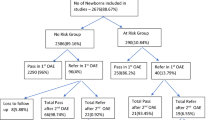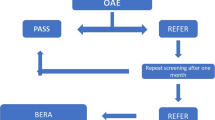Abstract
Many developed countries have well established universal neonatal hearing screening programs. In India, the viability of such a program, in an already overburdened health system is indeed a challenge. This cross sectional study was undertaken to evaluate the possible burden of hearing loss among neonates born at a tertiary care hospital in Southern India. Five hundred neonates were screened with automated distortion product otoacoustic emission (aDPOAE) for hearing loss, 9.2% of whom had one or more high risk factors. Although 6.4% had hearing loss at initial assessment, only 1.6% had hearing loss on retesting with aDPOAE. Retesting with OAE before an automated Auditory brainstem response (aABR) helped to exclude patients without hearing loss. The frequency of moderate to moderately severe hearing loss in this study was 0.6%. This pilot study underscores the importance of the introduction of screening for congenital deafness in specialized centers in India, despite its challenges.
Similar content being viewed by others
References
Mauk GW, Behrens TR (1993) Historical, political and technological context associated with early identification of hearing loss. Seminars in Hearing 14:1–17
Northern JL. Hayes DH (1994) Universal screening for infant hearing impairment: necessary, beneficial and justifiable. Audiology Today 6:10–13
Parving A (1993) Congenital hearing disability: epidemiology and identification: a comparison between two healthy authority districts. Int J Pediatr Otorhinolaryngol 27:29–46
Watkins P, Baldwin M, Mc Enery G (1991) Neonatal at risk screening and the identification of deafness. Arch Dis Child 66:1130–1135
Kim SY, Bothwell NE, Backousn DD (2002) The expanding role of the otolaryngologist in managing infants and children with hearing loss. Otolaryngol Clin N Am 35:699
Michele AM De. (2004) Newborn hearing screening. eMedicine 1–14
White KR, Vohr BR, Behrens TR (1993) Universal newborn hearing screening using transient evoked otoacoustic emissions: Results of the Rhode Island hearing assessment project. Seminars in Hearing 14:18–29
Isaacson G (2001) Universal Newborn Hearing Screening and Intervention. Advances in Otolaryngology-Head and Neck Surgery 15:1–19
White K, Maxon A (1995) Universal screening for the hearing impairment: simple, beneficial and presently justified. Int J Pediatr Otorhinolaryngol 32(3):201–211
Mehl A, Thompson V (1998) Newborn hearing screening: The Great omission. Pediatrics 101:1
Norton SJ, Gorga MP, Widen JE (2000) Identification of neonatal hearing impairment: Summary and Recommendations. Ear & Hearing 21:529–535
Joint Committee on infant hearing(1994) Joint Committee on Infant Hearing (JICH)1994 position statement. Pediatrics 95:152–156
Author information
Authors and Affiliations
Corresponding author
Rights and permissions
About this article
Cite this article
John, M., Balraj, A. & Kurien, M. Neonatal screening for hearing loss: pilot study from a tertiary care centre. Indian J Otolaryngol Head Neck Surg 61, 23–26 (2009). https://doi.org/10.1007/s12070-009-0028-2
Published:
Issue Date:
DOI: https://doi.org/10.1007/s12070-009-0028-2




